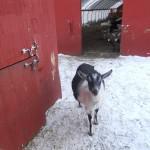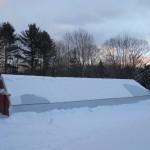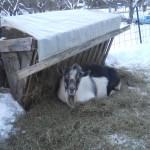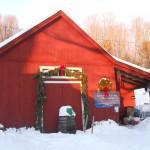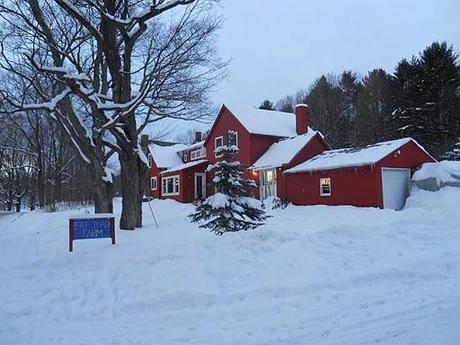 As a native Vermonter I’ve long had an affinity for a number of Vermont made food products. From Ben & Jerry’s ice cream to cheeses to micro-breweries, if it is made in Vermont, and I can either eat it or drink it, it’s almost a certainty that I’ll buy it.
As a native Vermonter I’ve long had an affinity for a number of Vermont made food products. From Ben & Jerry’s ice cream to cheeses to micro-breweries, if it is made in Vermont, and I can either eat it or drink it, it’s almost a certainty that I’ll buy it.
A Vermont product that recently captured both my imagination and my taste buds is “cajeta” or goat’s milk caramel. It’s similar to dulce de leche, delicious on a variety of desserts—ice cream, fruit and crepes to name just a few—and traditionally made in Mexico. Though located a few thousand miles from the historical epicenter of cajeta production in Celaya, Mexico, the Fat Toad Farm in tiny Brookfield, Vermont has started to produce unbelievably delicious goat’s milk caramel. After developing a mild addiction to this copper colored confection this past December, I was intrigued and vowed to visit the farm on my next trip home. As fate would have it, that trip happened to be in the middle of one of the snowier winters in recent history.
This is how I found myself carefully navigating my rented Chevrolet Impala through the snowy, backcountry roads of hilly Brookfield. Driving such roads can be perilous in a familiar vehicle equipped with snow tires; attempting them in a rented vehicle with worn all-season radials is foolish. As the wrong turns accumulated and as I drove further into the snowy countryside, I started to feel that prudence, not to mention my wife’s rapidly diminishing reserve of patience, would require me to abort my mission. Just as this was beginning to settle in, the Fat Toad Farm, my prized destination, suddenly appeared on the left behind two very large elm trees.
Coming to a stop in the farm’s driveway, the first thing I noticed was the small scale of the farm. The only thing I saw was the farm’s small retail store and a sturdy, picturesque farmhouse. As I got out of the car, the frigid air sent an arctic blast through my entire body. The snow crackled under foot as I approached the store and noticed that the lights were off and it was unattended. I tried the door and discovered that it was unlocked, and almost immediately upon the opening the door a cat darted through my legs into the relative warmth of the unheated store. Though I had on numerous occasions had Fat Toad’s cajeta, I was excited to try some of their goat cheese (chèvre ). After a few moments inspecting the store, I did not see any of the cheese. Unable to coax the cat out of the store and unsure of my next move, I decided to report back to my wife who was holed up in the car.
Just as I reached the car, a young woman popped her head out of the adjacent farmhouse and asked if she could help me. I apologized about arriving late on a Sunday in dead of winter, but was in the area and hoped to take a peek at the farm. I was also hoping to buy some of the farm’s goat cheese since I had not yet been able to find any in back in Washington, DC. She said that it wasn’t milking season, so there wasn’t any fresh milk for making the cheese, but I was welcome to go see the goats and pointed in their direction. After thanking her and walking in the direction indicated, I now noticed a sign that said “Goats This Way” and a snowy path. After following the snowy path to top of a hill, I glanced down the other side I saw a large, white structure.
This large white structure was the barn. The barn, or “goat house” in Fat Toad parlance, was not a traditional barn. It consisted mostly of an immense, white plastic cover fastened to an equally immense metal frame. Meandering in a fenced area in front of the barn was a hardy Alpine goat, perhaps out for a breath of brisk, 8 degree Vermont air. Upon approaching the lone goat, two other goats poked their heads out of the barn’s front door. Glancing into the structure was a substantial herd of goats vigorously chomping on organic grain and hay. Perhaps hoping that I had a treat hidden away in my coat pocket, the goat I initially spotted drew closer. The goat’s fur was black in its hind quarters and white in the front and on its chest, and had big black eyes and a salt and pepper nose. Feeling guilty for not having a treat, I decided to inspect the barn from a different angle and walked to the opening in the back.
From the back of the farm I could get a better view and saw a happy herd of perhaps 30 Alpine and Saanen goats. Though they are the star of the show, the goats are just one part of the operation. The farm also has pigs that feed on organic grain, leftover food scraps and veggies, and whey from the cheese making process. Rounding out the lineup are the farm’s 40 chickens which, like the pigs, act like cleanup of crew of sorts, eating insects, whey from the cheese making, along with grass and organic grain. During the summer the farm sells their organic eggs at their store and at the nearby Turkey Hill Farm. After sometime watching the goats and contemplating the difficulty involved in making a Mexican confection at a goat dairy in the backcountry of Vermont, I began to notice a few snowflakes falling from the sky. Having seen the goats and fearful that the already treacherous roads would become impassable, I decided to return to my car.
However, as I got to the top of the hill I noticed a pen with a buck (male goat) inside that I had missed in my haste to find the goat house. The goat seemed to be middle-aged. Due to its long snout and a tuft of hair on its head, this proud goat reminded me of the title character of the 80’s sitcom ALF In the show, ALF was a furry alien who landed on earth and was given refuge by a quirky, middle class family. The series ended with ALF’s fate never revealed. The final episode ended with a mere “To be continued” after ALF was captured by the U.S. military. Looking at ALF’s doppelganger in the pen, I wonder if these snowy hills of central Vermont were my home planet, or, if after many years living away, I was now an alien.
I left the question aside and jogged down the hill back to the car. The snow was coming down faster now, and I needed clear the woods soon to track down another Vermont specialty. Vermont craft-brewed beers of all varieties were waiting, and I was on the road to find them.
Fat Toad Farm
The Fat Toad Farm’s store is open everyday between 8AM and 6 PM. They have a self-guided tour and informational brochures available at the store. Their goat’s milk caramel can be purchased from website (www.fattoadfarm.com) and an increasingly large number of gourmet food stores throughout the country. Fat Toad is part of the Floating Bridge Food and Farm Cooperative. The cooperative is dedicated to producing nutritious foods through sustainable farming practices (www.floatingbridgefoodandfarms.com).
[Image by author]
Jason Wheelock was born and raised in central Vermont. He currently resides in Arlington, Virginia.